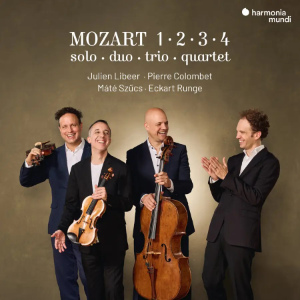
Wolfgang Amadeus Mozart (1756-1791)
MOZART 1 · 2 · 3 · 4
Piano Quartet No. 1 in G minor K. 478 (1785)
Piano Trio No. 3 in B-flat major K. 502 (1786)
Sonata for Piano and Violin No.25 in F major K. 377 (374e) (1781)
Piano Sonata No. 4 in E-flat major K. 282 (189g) (1774)
Julien Libeer (piano)
Pierre Colombet (violin)
Eckart Runge (cello)
Máté Szűcs (viola)
rec. 2024, Westvest 90, Schiedam, The Netherlands
Reviewed as lossless download
Harmonia Mundi HMM902699 [82]
Concert programs where the chamber ensemble shuffles the number of players between pieces are fairly rare – occasionally one might have a single player sit out one piece – and the same can be said for recordings. So the new release shows a welcome degree of imagination: works for one, two, three and four players. The pedantic among us might notice the difference between the title and the order of programming, but let’s overlook it.
Mozart’s chamber music, with the possible exception of some of the string quartets and piano sonatas, receives less attention than his operas and orchestral music, but this is Mozart after all, so there is quality in basically everything he wrote. Pianist Julien Libeer sought out three string-playing friends, each belonging to a prominent string quartet, to put this piano-centred program together, having to fit the recordings in between the schedules of their “day jobs”.
In this era of streaming, it doesn’t really matter whether one already owns a recording of a particular piece, but to my surprise, of the four works, the only one missing previously from my collection was the piano trio. The quartet was represented in my collection by the highly regarded recording of Paul Lewis and the Leopold String Trio on Hyperion (review), and I felt this new recording was superior in capturing the work’s dark drama; the sound was better as well. In the violin sonata, Colombet and Libeer are up against Arthur Grumiaux and Walter Klein (Philips), which is a big ask, and it is no criticism to say they aren’t quite as good. In the piano sonata, Libeer doesn’t quite have the poetry of Mitsuko Uchido (Philips), but his playing has other virtues which still make it a very fine reading. From the list of almost forty in my Piano Trio discography for K502, I chose the great Florestan Trio (review) to stream for comparison. Again this asks a lot of the new recording, and Libeer, Colombet and Runge were not found wanting, though I would still plump for the now sadly defunct English trio.
As you can tell from the above, the performances are, at the very least, very good, brimming with charm and vivacity. I was very impressed by the playing of Julien Libeer, whose name was unfamiliar to me before this recording. He is, of course, the centre of the recording, and across all four works, he sounds just right. However, I did not warm to the timbre of Pierre Colombet’s violin, finding it rather wiry, especially in the Trio, where my lukewarm impression wasn’t helped by a poorer sound quality – more diffuse but also with a harder edge – than the rest of the recording. The booklet notes are concise but informative.
All in all, the imaginative programming and the playing in general have much to commend them.
David Barker
Buying this recording via a link below generates revenue for MWI, which helps the site remain free



















